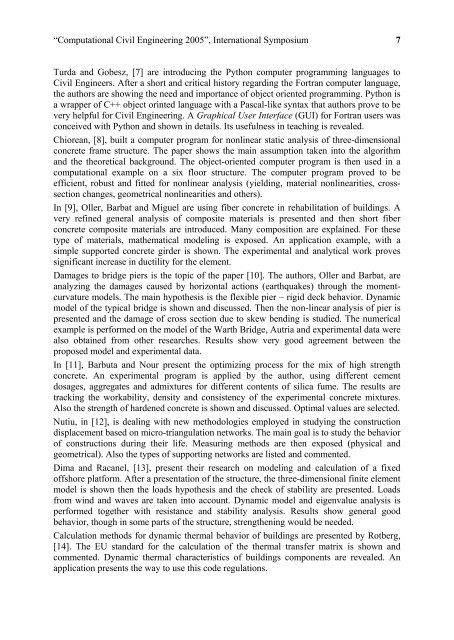âComputational Civil Engineering - "Intersections" International Journal
âComputational Civil Engineering - "Intersections" International Journal
âComputational Civil Engineering - "Intersections" International Journal
Create successful ePaper yourself
Turn your PDF publications into a flip-book with our unique Google optimized e-Paper software.
“Computational <strong>Civil</strong> <strong>Engineering</strong> 2005”, <strong>International</strong> Symposium 7Turda and Gobesz, [7] are introducing the Python computer programming languages to<strong>Civil</strong> Engineers. After a short and critical history regarding the Fortran computer language,the authors are showing the need and importance of object oriented programming. Python isa wrapper of C++ object orinted language with a Pascal-like syntax that authors prove to bevery helpful for <strong>Civil</strong> <strong>Engineering</strong>. A Graphical User Interface (GUI) for Fortran users wasconceived with Python and shown in details. Its usefulness in teaching is revealed.Chiorean, [8], built a computer program for nonlinear static analysis of three-dimensionalconcrete frame structure. The paper shows the main assumption taken into the algorithmand the theoretical background. The object-oriented computer program is then used in acomputational example on a six floor structure. The computer program proved to beefficient, robust and fitted for nonlinear analysis (yielding, material nonlinearities, crosssectionchanges, geometrical nonlinearities and others).In [9], Oller, Barbat and Miguel are using fiber concrete in rehabilitation of buildings. Avery refined general analysis of composite materials is presented and then short fiberconcrete composite materials are introduced. Many composition are explained. For thesetype of materials, mathematical modeling is exposed. An application example, with asimple supported concrete girder is shown. The experimental and analytical work provessignificant increase in ductility for the element.Damages to bridge piers is the topic of the paper [10]. The authors, Oller and Barbat, areanalyzing the damages caused by horizontal actions (earthquakes) through the momentcurvaturemodels. The main hypothesis is the flexible pier – rigid deck behavior. Dynamicmodel of the typical bridge is shown and discussed. Then the non-linear analysis of pier ispresented and the damage of cross section due to skew bending is studied. The numericalexample is performed on the model of the Warth Bridge, Autria and experimental data werealso obtained from other researches. Results show very good agreement between theproposed model and experimental data.In [11], Barbuta and Nour present the optimizing process for the mix of high strengthconcrete. An experimental program is applied by the author, using different cementdosages, aggregates and admixtures for different contents of silica fume. The results aretracking the workability, density and consistency of the experimental concrete mixtures.Also the strength of hardened concrete is shown and discussed. Optimal values are selected.Nutiu, in [12], is dealing with new methodologies employed in studying the constructiondisplacement based on micro-triangulation networks. The main goal is to study the behaviorof constructions during their life. Measuring methods are then exposed (physical andgeometrical). Also the types of supporting networks are listed and commented.Dima and Racanel, [13], present their research on modeling and calculation of a fixedoffshore platform. After a presentation of the structure, the three-dimensional finite elementmodel is shown then the loads hypothesis and the check of stability are presented. Loadsfrom wind and waves are taken into account. Dynamic model and eigenvalue analysis isperformed together with resistance and stability analysis. Results show general goodbehavior, though in some parts of the structure, strengthening would be needed.Calculation methods for dynamic thermal behavior of buildings are presented by Rotberg,[14]. The EU standard for the calculation of the thermal transfer matrix is shown andcommented. Dynamic thermal characteristics of buildings components are revealed. Anapplication presents the way to use this code regulations.













